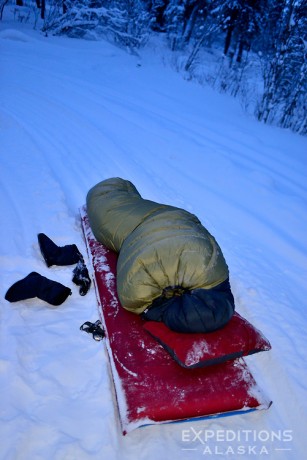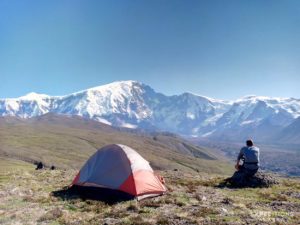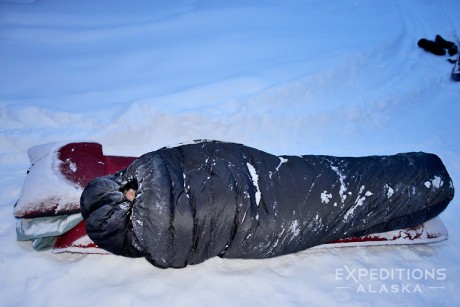
Hey Folks,
It’s January, and Alaska can be a rough place to sleep outside during this time of year. Temperatures can easily be down below zero F, even into the minus 30’s and 40’s, or colder. So sleeping outside is not to be taken lightly.
Bring a good sleeping bag. A REALLY good sleeping bag. If you predict temperatures of zero (F), I’d go with a sleeping bag rated to minus 20 degrees F. I prefer a down sleeping bag over synthetic bags, but the key is a high quality, and well rated bag. If you have a good synthetic fill sleeping bag, use that. It’ll be heavier, and less compatible, but you can deal with that. You don’t want to have to deal with being cold.
Your bag is your last refuge against the cold. Don’t skimp on it. Bring “more” sleeping bag than you think you need. I do like the goretex or similar shells for winter bags, and highly recommend them.
Bring a good sleeping pad. A REALLY good sleeping pad. Jake, above, is using (well, half using) an Exped Sim Comfort 10 LW, which I highly recommend if you’re not packing it into the backcountry. If you need to haul it (snowshoeing, skiing, backpacking, go with an Exped Downmat 7 or even the Downmat 9). An insulated pad insulates you against the cold snow underneath, where even the best sleeping bag won’t offer much protection – once you lie down in the bag and compress the insulation underneath you (be it down or synthetic), it offers little insulating value. So a high quality insulated pad makes a huge difference. You want it to be about an inch or more thick.
Although it’s not generally needed with a high quality sleeping pad like this, I often like to throw a hard cell foam pad under the inflatable. It adds a little extra insulation, but mostly a little protection against a leak or anything. It’ll definitely ad to the life of your sleeping pad. Unlike Jake, above, don’t slide off the sleeping pad. You’ll get cold. 🙂
Go to bed warm. All your bag is going to do is insulate (i.e., hold in and trap) the heat your body gives off. If you’re cold, your body is not giving off much heat, it’s trying to conserve heat by shunting blood toward your core. In other words, externally, you’re not giving off much heat. So the bag will take an inordinately long time to feel warm. Go to bed warm.
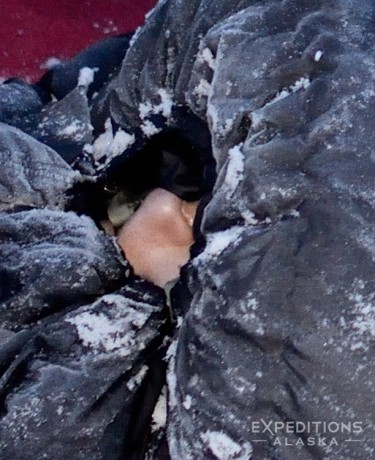
Learn to sleep bundled up. The biggest mistake people make is expecting a sleeping bag will keep you warm down to its rated temperature if you leave it half open. Hunker down; zip it all the way up, velcro the collar and flaps closed, tighten down your collar cords and leave as little space as possible for your face. The more skin you expose to the air outside, the more heat you lose. You can see Jake has hunkered down all the way, leaving just enough room for breathing.
You don’t want to keep your mouth/nose inside the bag, as your breath will be pumping moisture into the bag, and this isn’t going to be a good thing, particularly for a multi-day trip. your body already is expelling moisture into the bag, and you don’t want to add any more than necessary. You can see just the tiniest bit of frost around the opening near Jake’s nose/mouth above; it’s mostly just snow on the outside of the bag.
Don’t stress out when you wake up in a hunkered down sleeping bag like this. You probably will. It’s a weird feeling waking up and not being able to get out; yo can’t find the cords, or the zipper is stuck, etc, and you feel trapped. It’s not for the claustrophobic. The key is not to stress out, stay calm, and be patient with yourself. Carefully reach for the cords, or the zipper, and take your time. You’ll get out of there. Just be patient. And, if you really feel stuck, holler for help and one of your camping buddies can come over and let you out. Don’t be embarrassed; it happens to lots folks.
Don’t overlayer; going to bed with a simple pair of longjohns, a comfortable base layer top (wool or synthetic), and some kind of hat (wool or fleece) is usually enough;. If not, bring a warmer sleeping bag. Keep some extra layers loose inside your bag and they’ll be toasty warm when you get dressed in the morning.
Sometimes a fleece face mask is a good idea as well; often, if it’s really cold, your eyes, nose and mouth get cold. Just a light layer over your face can be helpful. I generally prefer not to lie anything over my mouth/nose, as it’s too easy for the moisture from your breath to freeze up against it, which can cause breathing problems, as well make you colder.
This shot was taken mid-January on a trip over to Wrangell-St. Elias National Park. The temperature this night got down to approx zero. Jake is bundled up in a minus 40 deg F Mountain Hardwear Ghost sleeping bag, and slept soundly, and warmly. His dad was sleeping nearby in a Western Mountaineering Lynx sleeping bag (minus 10 deg F) and was plenty comfortable. Look at the photo again (above & below) and see all the snow lying on the bag. These are both awesome bags.
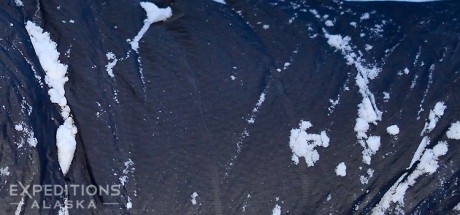
That’s a good indication the bag is working as it’s supposed to; keeping the heat inside the bag, the outside of the bag hasn’t melted or thawed the snow at all. The snow was from a light dusting in the middle of the night, and by morning (9:00am) none of it at all had melted or thawed and frozen. That’s what you want to see!
Some folks will recommend using a Nalgene bottle (or similar) filled with hot or warm water in your bag. it’ll definitely help add some heat, but you REALLY want to make sure the lid is screwed on tight. And if you take it out of the bag, expect the water to freeze and you won’t get the lid back off again – sometimes turning the bottle upside down helps, a s the ice forms at the top first. But at cold winter temps, the whole thing will freeze).
Other general winter camping tips
- Having dry gear = having warm gear. Any wet or damp clothes, stick them in your bag (unless they’re soaking cold) and let your body heat dry them out at night. Include your boot insoles if you need to
- A snack or warm drink before bed can help a lot
- If you have to pee; go pee. Holding it in will make you colder
- Fleece/wool liner gloves can be helpful
- Don’t go to bed cold.
Most of all, have fun, and travel safe.
Cheers
Carl
